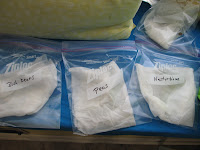We started out reviewing what physical and phase changes are, then jumped into chemical changes.
First on the list: rust! The day before, I had placed pennies on a paper towel soaked with vinegar, and they had developed a nice green layer of verdigris. I also had dredged up a variety of rusty tools and screws from the basement.
Rust is interesting because it is the same chemical reaction as fire:it's the addition of oxygen to a substance. It also, like fire, puts out a measurable amount of heat, if you can get the rust reaction going fast enough (steel wool in vinegar can be measured with a thermometer). Oxidation reactions are also the way we turn food into energy in our bodies!

Then it was time for one of my favorite chemicals: hydrogen peroxide! This stuff is great! At 3% it's an antiseptic. At 6% it's hair bleach. At 18% it's a stain remover. At 100% it's rocket fuel!
All that and it breaks down into harmless water and oxygen.
First we tried it on Choclo's scratch. It bubbled satisfactorily.
If you have a large enough reaction, those bubbles feel warm because breaking that extra oxygen off of hydrogen peroxide (2H
2O2 into 2H
2O and O2) breaks a chemical bond, which releases heat. Fortunately, Choclo's scratch was pretty small, so we just saw bubbles. Those bubbles are there because the peroxide is in contact with living cells.

Virtually all living cells make an enzyme which breaks down hydrogen peroxide. That's because all those cells make their own peroxide as a waste product in the energy cycle.
This makes peroxide an excellent "living cell detector!" Where could we find cells?

All over the kitchen! My favorite was testing both raw and cooked meat. The raw meat fizzed, and the cooked did not. We also did potatoes, bananas, mangoes, oranges, (all of which fizzed) and crackers, noodles, lentils, and pretzels (none of which reacted).

I had intentionally included some starches because the next experiment tested the same group, this time with iodine!
All the starches turned black. You can also see one of our "rusty" pennies on this plate.

But starches are just complex carbohydrates, and complex carbohydrates are made of simple carbohydrates (sugars).

The iodine turned flour an instant black, but in the sugar it had no change at all.
I had the kids chew crackers for a minute without swallowing so they could taste the change as their mouth enzymes broke the starchy crackers into sugars.
Next we dropped an egg into vinegar. The vinegar reacted with the calcium in the shell, and formed bubbles. It takes two days for this reaction to finish.

Fortunately, I had started an egg two days before!
Shell-less eggs are fascinating!
For one thing, the membrane is rubbery and translucent. You can see the yolk rolling around inside.

For another, soaking in the vinegar,
the egg has absorbed a lot of water, and so is quite a bit larger than it used to be!
And, when lobbed on the driveway, it gives an amazing grand finale to your science class (and proves that it really was a raw egg)!

 I did a peephole diorama with the extra "too small" pictures.
I did a peephole diorama with the extra "too small" pictures.















































